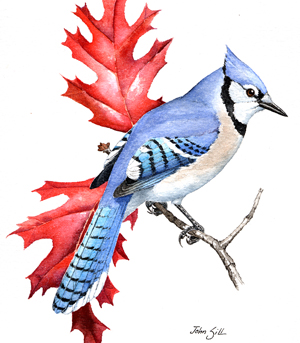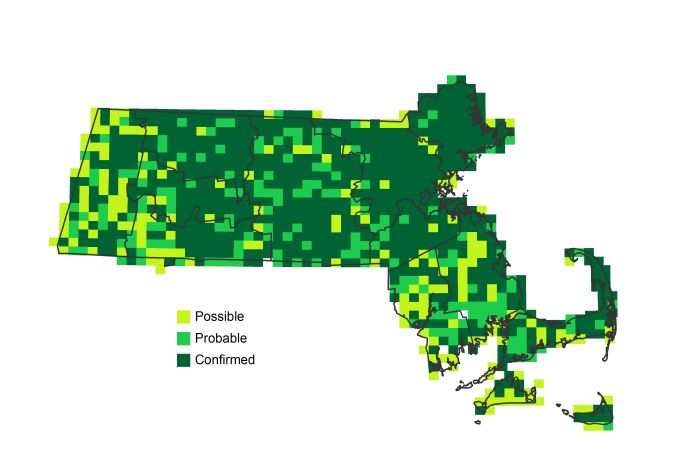Find a Bird
Blue Jay
Cyanocitta cristata

Nearly ubiquitous and stable
Action/monitoring needed
“What: is the jay more precious than the lark, / Because his feathers are more beautiful?” – William Shakespeare, The Taming of the Shrew
Though they may be the most visually striking of all backyard birds, the impressiveness of Blue Jays is somewhat diminished by their ubiquity. These handsome birds are known to just about every child and adult in the Commonwealth. They are a common sight swooping through the suburbs in search of food, announcing their presence with raucous cries. Although they are often derided as rascals and bullies, the success of Blue Jays in Massachusetts is a testament to the birds’ survivor spirit.
Historic Status
Blue Jays historically occupied the forests of the Commonwealth, but quickly adapted to human changes to the landscape, and accordingly their populations have never wavered in Massachusetts. William Peabody noted in the mid-1800s: “These birds are said to abound at the south in winter; but if any really migrate from Massachusetts, it must be but a small proportion; since, if a handful of corn be anywhere thrown upon the snow, it will be very soon surrounded with a busy and animated party” (Peabody 1839). Saturation of Massachusetts and the other five New England states by Blue Jays was well established throughout the first seven decades of the twentieth century.
Atlas 1 Distribution
Blue Jays were loudly advertising their presence during Atlas 1. Only a handful of blocks west of the Worcester Plateau lacked evidence of breeding Blue Jays. The Lower Worcester Plateau had half a dozen jayless blocks – a curiously high proportion, and potentially an artifact of survey effort, considering that the Coastal Plains region is more than three times as large but reported only a few more blocks devoid of jays. With the exception of some offshore blocks in the Harbor Islands, the Boston Basin was completely saturated with breeding Blue Jays. Jays were ubiquitous in the Bristol/Narragansett Lowlands as well. While still very widespread on Cape Cod and the Islands, it was within this region that the species was missing from the greatest number of blocks. Most absences were from offshore island blocks where there was little land area, and accordingly there were few of the mast trees like oak and beech that jays depend on for food in the absence of people.
Atlas 2 Distribution and Change
Suburban residents continued to observe the splash of vibrant color that Blue Jays brought into their neighborhoods during the inter-Atlas period. The species was remarkably persistent in the western regions, losing no territory whatsoever west of the Worcester Plateau and even gaining a handful of new blocks. Incremental dips and tiny gains were reported from the more easterly ecoregions, where Blue Jays were once again found in the overwhelming majority of blocks.
Atlas 1 Map

Atlas 2 Map

Atlas Change Map

Ecoregion Data
Atlas 1 | Atlas 2 | Change | ||||||
Ecoregion | # Blocks | % Blocks | % of Range | # Blocks | % Blocks | % of Range | Change in # Blocks | Change in % Blocks |
Taconic Mountains | 16 | 100.0 | 1.7 | 24 | 96.0 | 2.4 | 0 | 0.0 |
Marble Valleys/Housatonic Valley | 39 | 100.0 | 4.2 | 39 | 100.0 | 3.9 | 0 | 0.0 |
Berkshire Highlands | 55 | 100.0 | 6.0 | 55 | 100.0 | 5.5 | 0 | 0.0 |
Lower Berkshire Hills | 28 | 100.0 | 3.1 | 31 | 100.0 | 3.1 | 0 | 0.0 |
Vermont Piedmont | 16 | 94.1 | 1.7 | 17 | 100.0 | 1.7 | 0 | 0.0 |
Berkshire Transition | 36 | 94.7 | 3.9 | 40 | 100.0 | 4.0 | 1 | 3.2 |
Connecticut River Valley | 56 | 100.0 | 6.1 | 64 | 98.5 | 6.4 | 0 | 0.0 |
Worcester Plateau | 76 | 97.4 | 8.3 | 88 | 100.0 | 8.9 | 0 | 0.0 |
Lower Worcester Plateau | 68 | 91.9 | 7.4 | 79 | 98.8 | 7.9 | 1 | 1.9 |
S. New England Coastal Plains and Hills | 261 | 96.7 | 28.4 | 279 | 98.6 | 28.1 | 2 | 0.9 |
Boston Basin | 52 | 92.9 | 5.7 | 51 | 91.1 | 5.1 | -2 | -3.6 |
Bristol and Narragansett Lowlands | 104 | 98.1 | 11.3 | 104 | 91.2 | 10.5 | -2 | -2.0 |
Cape Cod and Islands | 111 | 81.6 | 12.1 | 123 | 85.4 | 12.4 | 3 | 2.5 |
Statewide Total | 918 | 94.7 | 100.0 | 994 | 95.9 | 100.0 | 3 | 0.4 |
Notes
Despite this apparent stability, the Breeding Bird Survey (BBS) shows significant declines in the Blue Jay abundance for Massachusetts, the New England/Mid-Atlantic Region, and the Eastern US overall. They fall into our “whispering bird” category – those species with a demonstrated stable or increasing breeding footprint from Atlas 2 data, but also a demonstrated decline in abundance from the BBS. This drives our final assessment that this is a species with a need for further monitoring.



